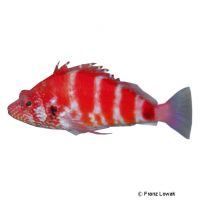Redbarred Hawkfish (Cirrhitops fasciatus)
| Redbarred Hawkfish Cirrhitops fasciatus | |
|---|---|
| Name | Redbarred Hawkfish |
| Name Lat. | Cirrhitops fasciatus |
| Family | Hawkfishes |
| Family lat. | Cirrhitidae |
| Order | Basses |
| Order lat. | Centrarchiformes |
| Origin | Indo-West Pacific |
| Habitat | Reefs |
| Diet | Carnivore |
| pH | 8.1-8.4 |
| Hardness | 8-10 °KH |
| Behavior | Aggressive |
| Keeping | Pair, harem |
| Reef Compatible | With caution |
| Care Level | Moderate |
| Life Span | 3-5 years |
| Protection | No |
| Metric Units | |
| Size | 12 cm |
| Temperature | 22-27 °C |
| Salinity | 33-36 ‰ |
| Aquarium | ~ 250 l |
| US Units | |
| Size | 5" |
| Temperature | 72-81 °F |
| Salinity | 1.020-1.025 sg |
| Aquarium | ~ 65 gal |
Distribution and habitat
The Cirrhitops fasciatus are widely distributed from Madagascar, Mauritius and Reunion to southern Japan and Hawaii. There they live in the clear water of lagoons and on surf-protected outer reefs with rich coral growth up to 50 m depth.
Maintenance
They require a well-structured aquarium with a reef structure that provides hiding and retreat opportunities and coral pinnacles that serve as exposed perching sites for them
Only lime-rich, heavy metal-free substrates should be used as substrate. To ensure water quality, filters, skimmers and heaters are necessary, as well as pumps to simulate tides, swells and bottom currents. It is recommended that live stones be used to set up the aquarium. The bacteria living in the porous stones act as a biological filter
The lighting must correspond to the species-appropriate day-night rhythm of the animals
| Salinity: 33-36 ‰ | pH value: 8.1-8.4 |
| Carbonate hardness: 8-10 °KH | Nitrate content: 2-8 mg/l |
| phosphate content: 0.01-0.1 mg/l | nitrite content: 0.0-0.05 mg/l |
For salinity, an average value should be aimed for, which may only vary slightly by +/- 0.5 ‰. Ammonia and ammonium must not be measurable. Special attention must be paid to constantly good water quality.
Diet
They are voracious lurkers that prefer to eat shrimp and crustaceans in the wild. The change of food is usually unproblematic. The diet should consist of a combination of live and frozen foods, such as artemia, mysis, shrimp, and krill, with chopped fish, clam, and shrimp meat or a commercial vitamin-enriched frozen food mix supplemented with live feeder shrimp. Dry food is not accepted. It is recommended to feed larger portions 1-2 times a day.
Regular and varied feeding promotes health and increases resistance.
Behaviour and compatibility
It is recommended to keep them in pairs. The larger, dominant animal always develops into the male. They are moderately territorial and often defend only a specific area of a coral. Interspecific aggression usually occurs only through food competition. A socialization with other fish is well possible, but it can come to disturbances with new additions by intrusive curiosity.
Sex dimorphism
They are protogynous hermaphrodites, i.e. males develop from functional females when needed. No external distinguishing characteristics are known.
Reproduction and breeding
Spawning occurs in the evening or at night near the water surface. In the process, the fish catapult themselves synchronously upwards and then immediately return to the starting point
There are no known reports of successful breeding in the aquarium.
Important
They choose hiding places (corals) from which they can overlook as large an area as possible and often lurk motionless for hours in search of prey. They are especially jumpy during the spawning process, so the aquarium should be well covered
As reef dwellers, they should only be kept together with corals and not in a fish-only aquarium
If different species are kept together, care should be taken to ensure that the fish match each other in terms of water quality and temperature requirements and social behavior, and that the setup meets the needs of all species kept together. New fish to be introduced must be acclimated slowly to the water in the aquarium
Further literature can be found in your pet store.
References
Text: Werner Winter; Image: Franz Lowak
Source: ENGELMANN (2005): Zootierhaltung - Tiere in menschlicher Obhut: Fische, Verlag Harri Deutsch
- Gemäß § 21 Abs. 5 Tierschutzgesetz idgF
